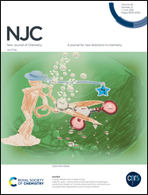Structural and electronic properties of FeCl3 and CrO3 interacting with GaP nanotubes from DFT calculations†
Abstract
Density functional theory based calculations were performed to study the modification of the electronic and structural properties originating from the interaction between the (10,0) GaPNT and the FeCl3 and CrO3 compounds, using the software SIESTA. The results show that, for both compounds interacting with the GaPNT, the structures remained practically the same with a small deformation. In all studied systems, FeCl3 acts as an acceptor of electrons while CrO3 as an electron donor. The binding energy showed that both the FeCl3 and CrO3 compounds interact strongly with the GaPNT through a chemisorption process. Projected density of states analysis shows that the electronic properties were drastically modified with the adsorption of the FeCl3 compound on the GaPNT due to the appearance of localized states in the gap region. In all systems, the band gap was reduced except in the case of CrO3 adsorbed outside the GaPNT, in which the band gap was increased. In the case of FeCl3 adsorbed inside the GaPNT, the system became metallic, while all the other systems remained semiconductors.



 Please wait while we load your content...
Please wait while we load your content...